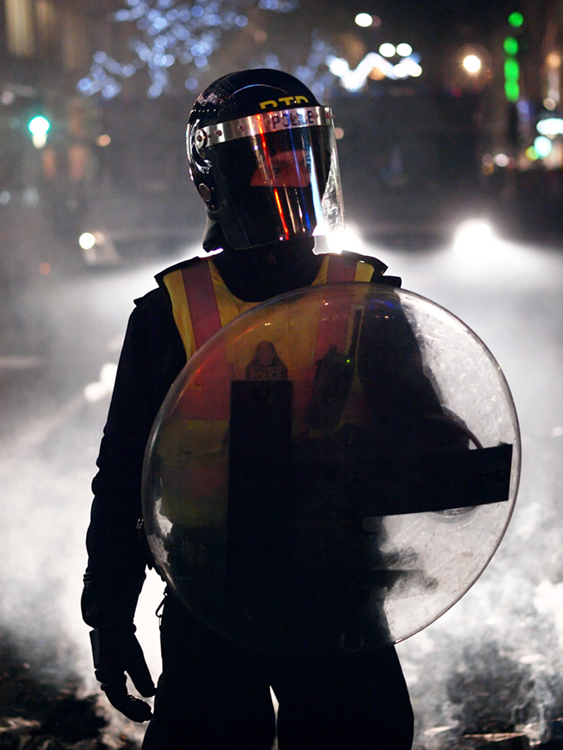| << Chapter < Page | Chapter >> Page > |
Neil Smelser’s (1962) meticulous categorization of crowd behavior, called value-added theory , is a perspective within the functionalist tradition based on the idea that several conditions must be in place for collective behavior to occur. Each condition adds to the likelihood that collective behavior will occur. The first condition is structural conduciveness , which describes when people are aware of the problem and have the opportunity to gather, ideally in an open area. Structural strain , the second condition, refers to people’s expectations about the situation at hand being unmet, causing tension and strain. The next condition is the growth and spread of a generalized belief , wherein a problem is clearly identified and attributed to a person or group.
Fourth, precipitating factors spur collective behavior; this is the emergence of a dramatic event. The fifth condition is mobilization for action , when leaders emerge to direct a crowd to action. The final condition relates to action by the agents. Called social control , it is the only way to end the collective behavior episode (Smelser 1962).
Let’s consider a hypothetical example of these conditions. In structure conduciveness (awareness and opportunity), a group of students gathers on the campus quad. Structural strain emerges when they feel stress concerning their high tuition costs. If the crowd decides that the latest tuition hike is the fault of the Chancellor, and that she’ll lower tuition if they protest, then growth and spread of a generalized belief has occurred. A precipitation factor arises when campus security appears to disperse the crowd, using pepper spray to do so. When the student body president sits down and passively resists attempts to stop the protest, this represents mobilization of action. Finally, when local police arrive and direct students back to their dorms, we’ve seen agents of social control in action.
While value-added theory addresses the complexity of collective behavior, it also assumes that such behavior is inherently negative or disruptive. In contrast, collective behavior can be non-disruptive, such as when people flood to a place where a leader or public figure has died to express condolences or leave tokens of remembrance.

Interactionist sociologist Clark McPhail (1991) developed assembling perspective , another system for understanding collective behavior that credited individuals in crowds as rational beings. Unlike previous theories, this theory refocuses attention from collective behavior to collective action. Remember that collective behavior is a non-institutionalized gathering, whereas collective action is based on a shared interest. McPhail’s theory focused primarily on the processes associated with crowd behavior, plus the lifecycle of gatherings. He identified several instances of convergent or collective behavior, as shown on the chart below.
| Type of crowd | Description | Example |
|---|---|---|
| Convergence clusters | Family and friends who travel together | Carpooling parents take several children to the movies |
| Convergent orientation | Group all facing the same direction | A semi-circle around a stage |
| Collective vocalization | Sounds or noises made collectively | Screams on a roller coaster |
| Collective verbalization | Collective and simultaneous participation in a speech or song | Pledge of Allegiance in the school classroom |
| Collective gesticulation | Body parts forming symbols | The YMCA dance |
| Collective manipulation | Objects collectively moved around | Holding signs at a protest rally |
| Collective locomotion | The direction and rate of movement to the event | Children running to an ice cream truck |
As useful as this is for understanding the components of how crowds come together, many sociologists criticize its lack of attention on the large cultural context of the described behaviors, instead focusing on individual actions.
Collective behavior is non-institutionalized activity in which several people voluntarily engage. There are four different forms of collective behavior: crowd, mass, public, and social movement. There are three main theories on collective behavior. The first, the emergent-norm perspective, emphasizes the importance of social norms in crowd behavior. The next, the value-added theory, is a functionalist perspective that states that several preconditions must be in place for collective behavior to occur. Finally the assembling perspective focuses on collective action rather than collective behavior, addressing the processes associated with crowd behavior and the lifecycle and various categories of gatherings.
Discuss the differences between a mass and a crowd. What is an example of each? What sets them apart? What do they share in common?
Can you think of a time when your behavior in a crowd was dictated by the circumstances? Give an example of emergent-norm perspective, using your own experience.
Discuss the differences between an acting crowd and a collective crowd. Give examples of each.
Imagine you are at a rally protesting nuclear energy use. Walk us through the hypothetical rally using the value-added theory, imagining it meets all the stages.
Blumer, Herbert. 1969. “Collective Behavior.” Pp. 67–121 in Principles of Sociology , edited by A.M. Lee. New York: Barnes and Noble.
LeBon, Gustave. 1960 [1895]. The Crowd: A Study of the Popular Mind . New York: Viking Press.
Lofland, John. 1993. “Collective Behavior: The Elementary Forms.” Pp. 70–75 in Collective Behavior and Social Movements , edited by Russel Curtis and Benigno Aguirre. Boston: Allyn and Bacon.
McPhail, Clark. 1991. The Myth of the Madding Crowd . New York: Aldine de Gruyter.
Smelser, Neil J. 1963. Theory of Collective Behavior . New York: Free Press.
Turner, Ralph and Lewis M. Killian. 1993. Collective Behavior . 4th ed. Englewood Cliffs, N. J., Prentice Hall.

Notification Switch
Would you like to follow the 'Introduction to sociology' conversation and receive update notifications?